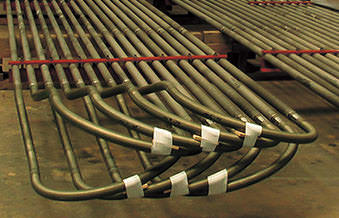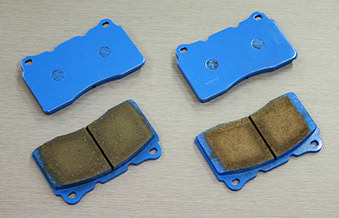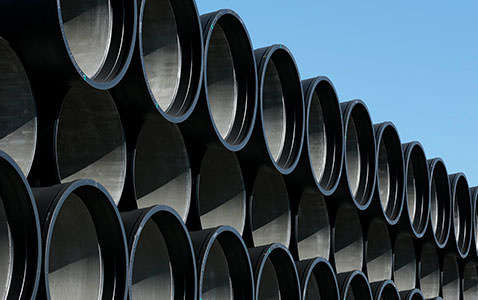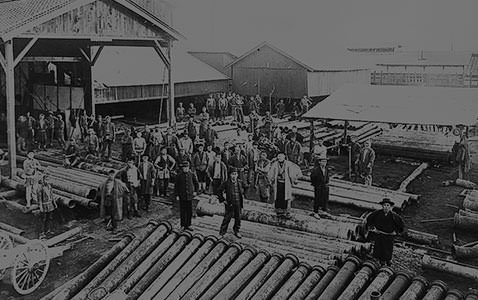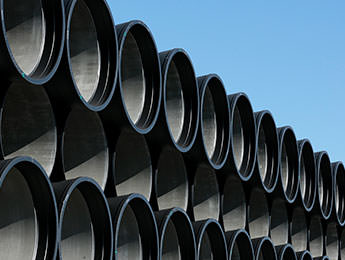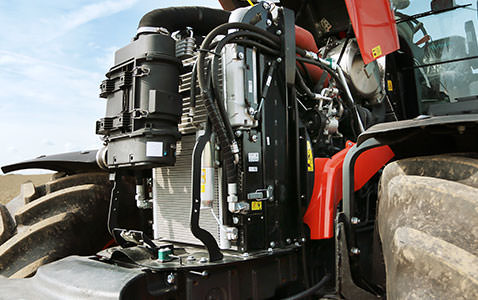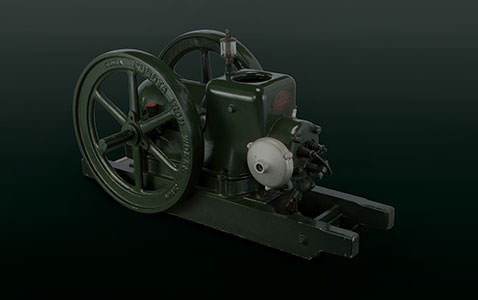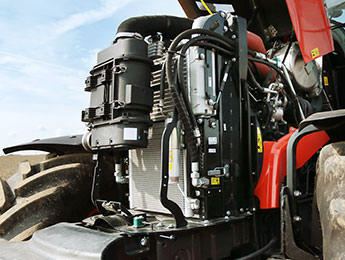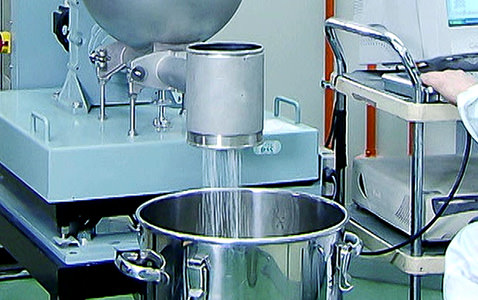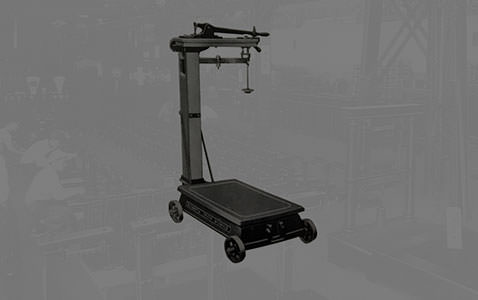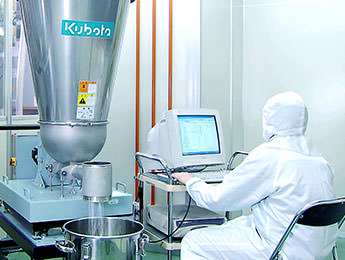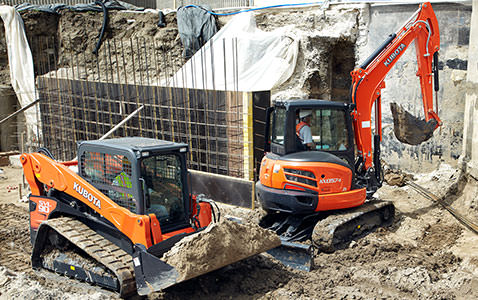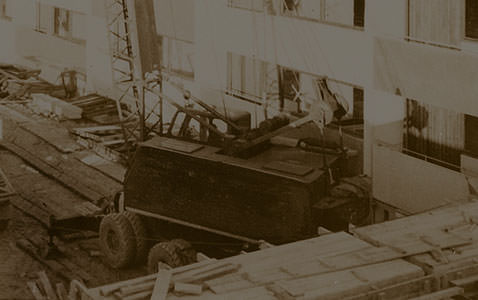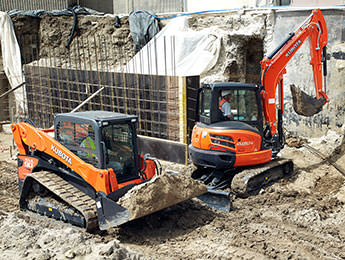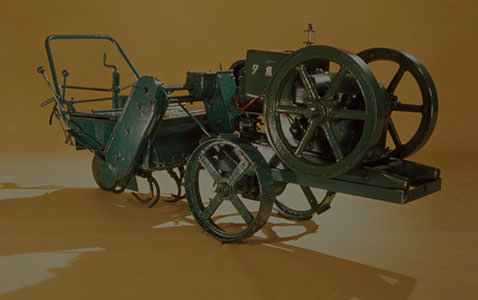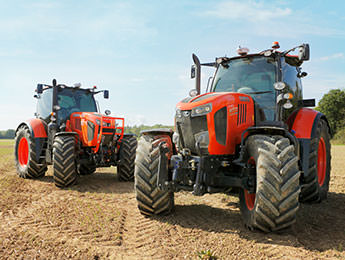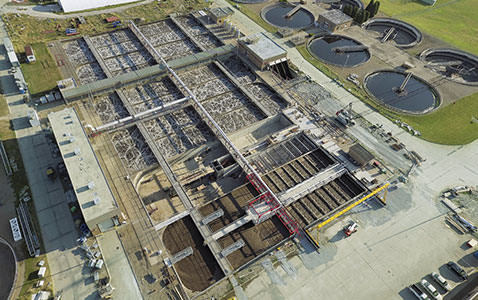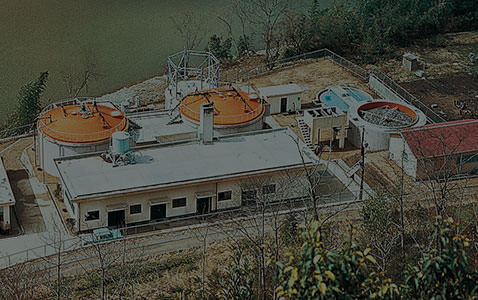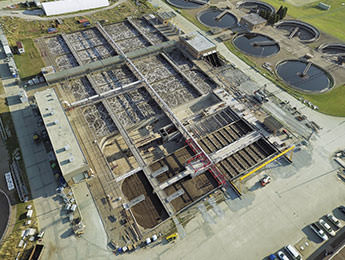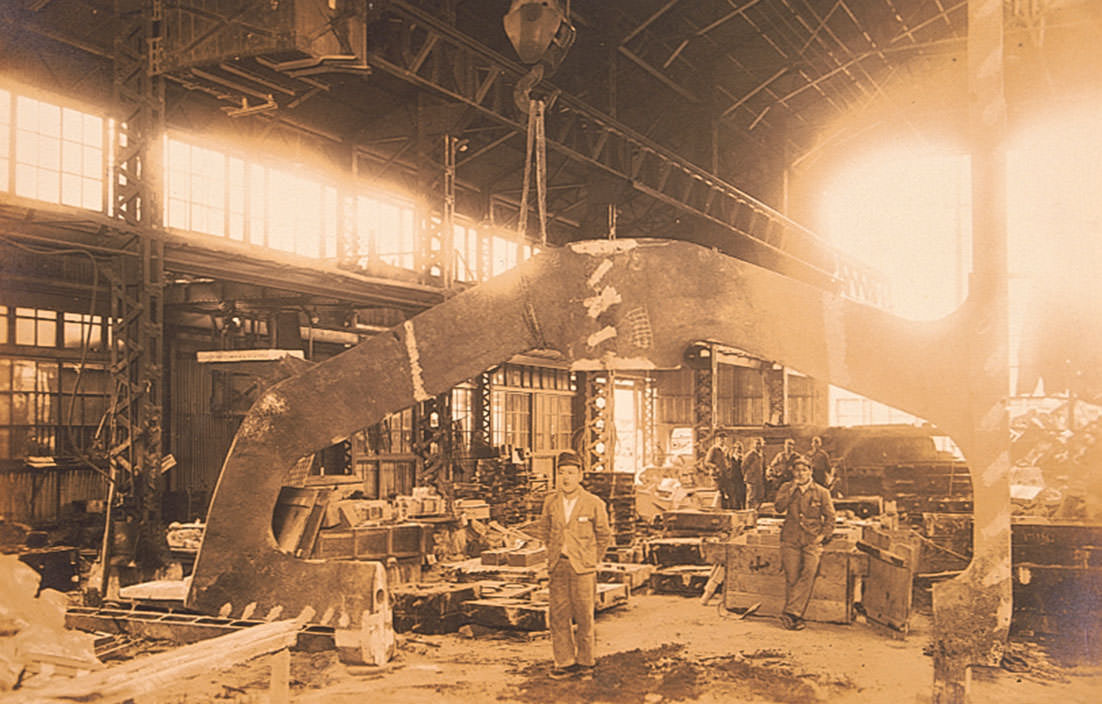
1930-1950s
Kubota’s Cast Steel Technology
Found New Opportunities in Special Steel Casting
Steel Ingot Mold, Ductile Cast Iron Roll
Large 3-ton keel manufactured at a steel casting foundry
Kubota opened its business under the name Ohde Casting in the 1890’s. Soon, its steel casting business became solid. As it had for some time been working on steel castings, Kubota succeeded in developing it in 1937 after much trial and error. It sought to produce unique products, in light of competitors and the transition to civilian demand after World War II.
Started Producing Steel Casting. Focusing on Special Steel Casting, Kubota Differentiated Itself from Other Steel Manufacturers
In order to expand its business, Kubota expanded the Okajima Plant which specialized in casting in 1937. Using an electric furnace it installed at this time, Kubota pondered whether it was possible to make steel castings that are much harder and well preserved than cast iron. This was the start of the cast steel business, which was the origin of Kubota’s materials business. With much trial and error, it succeeded in developing a 70mm-diameter gear and entered the cast steel market. At the time, as it was difficult to compete in the market with cast steel alone, Kubota focused on special steel casting, differentiating itself from competitors. In addition, it attempted to cast with wet sand mold, which was unconventional at the time, in order to reduce cost and improve efficiency.
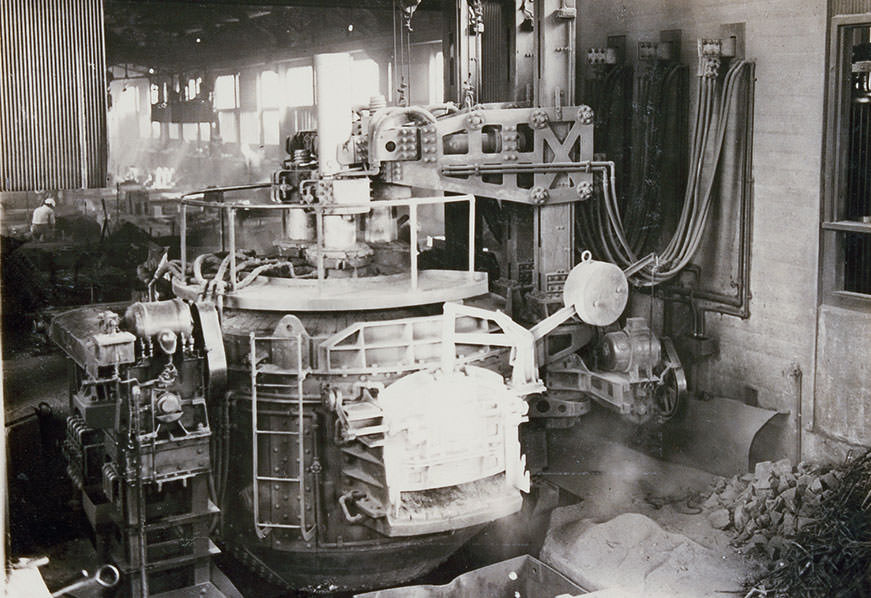 The 3-ton electric furnace installed during the expansion of the Okajima Plant
The 3-ton electric furnace installed during the expansion of the Okajima Plant
The First in the Country to Manufacture Steel Pipes Through Centrifugal Casting, Establishing Kubota’s Original Steel Casting
After the war, the cast steel business searched for a way to highlight Kubota’s originality. Before the war, Kubota became the first company in the country to succeed in manufacturing cast steel pipes applying the “centrifugal casting method,” which was first implemented in Asia as a technique to produce thin and long cast iron pipes. Later, it developed pipes with such high-class alloy steel as nickel steel and chromium steel and began the domestic production of these special cast steel pipes, which were all dependent on imports. In 1956, its record of producing cast steel pipes through centrifugal casting was recognized, and Kubota received the Incentive Award at the Mainichi Industrial Technology Award. It was a moment in which Kubota’s decision to steer the company toward special cast steel in the beginning of its business bore fruit.
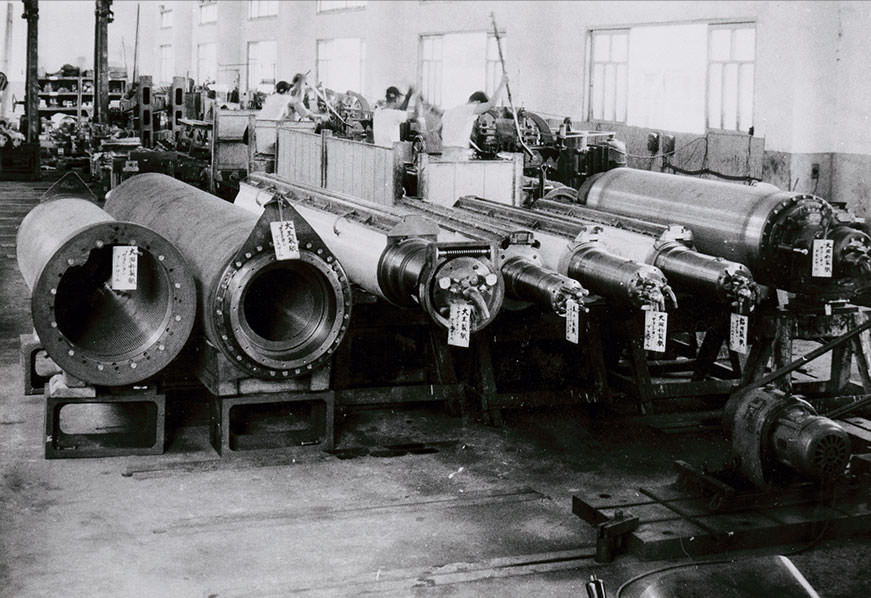 Steel casting-made paper suction roll shell in operation
Steel casting-made paper suction roll shell in operation
at paper-making machine manufacturer.
1950-1960s
As Japan Entered the Period of Rapid Economic Growth,
the Urban Infrastructure Developed
After Japan recovered from the war, the period of rapid economic growth arrived, accelerating the development of urban infrastructure. The demand for iron and steel increased as bullet train networks and coastal reclamation expanded and port facilities developed. The casting industry once again started to thrive, and fierce competition among manufacturers began.
Scroll to See Next Story
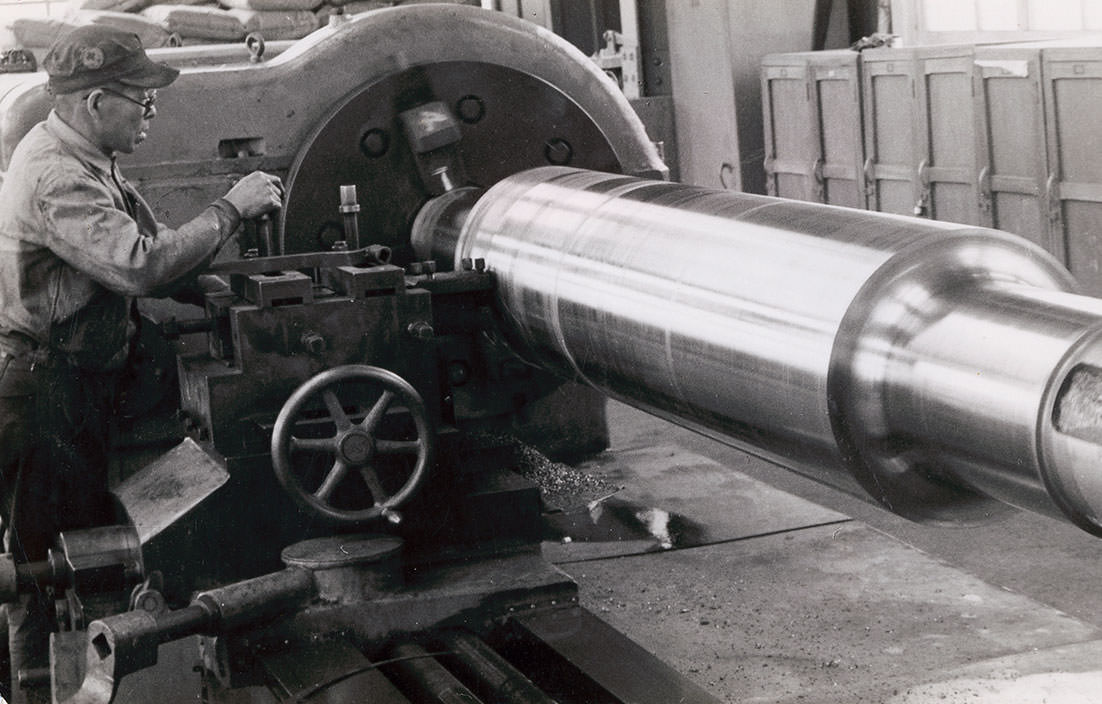
1950-1960s
Further Developing Product Originality,
Kubota Entered the New Field of Civil Engineering
G Column for Building Structure, Centrifugal Cast Composite Roll, Spiral Iron Pipe
Processing the lathe of a steel mill roll
After long and diligent experimental research, Kubota made the centrifugal casting technology for cast steel pipe its own. In order to further pursue product originality, it continued to carry on research and developed the welded cast steel pipes, centrifugal cast composite rolls, and spiral iron pipes. These supported the urban infrastructure improvement and shouldered under the rapid economic growth.
Expanded Its Products to Casting Materials for Civil Engineering and Construction. Selected as “Top 10 New Products of the Year”
As Kubota’s centrifugal casting of steel pipes received good reviews, its cast steel columns were adopted for Osaka City’s subway station buildings. Later, with its track record of supplying columns for Tokyo’s metro system as well, it collaborated with the Japanese National Railways Building Structure Research Institute and developed the columns for Tokaido Shinkansen’s Shin-Osaka Station in 1962. The resulting G Column had weld flanges, which connected the column and beams, cast together using centrifugal casting. The G Column could adjust its thickness depending on its use and also demonstrated excellent strength. Kubota developed a mass-production system and released this product as a construction material. It was widely used from skyscrapers to underground shopping centers and was selected by Nikkan Kogyo Shimbun (The Daily Industrial News, Ltd.) as “Top 10 New Products of the Year” in 1965.
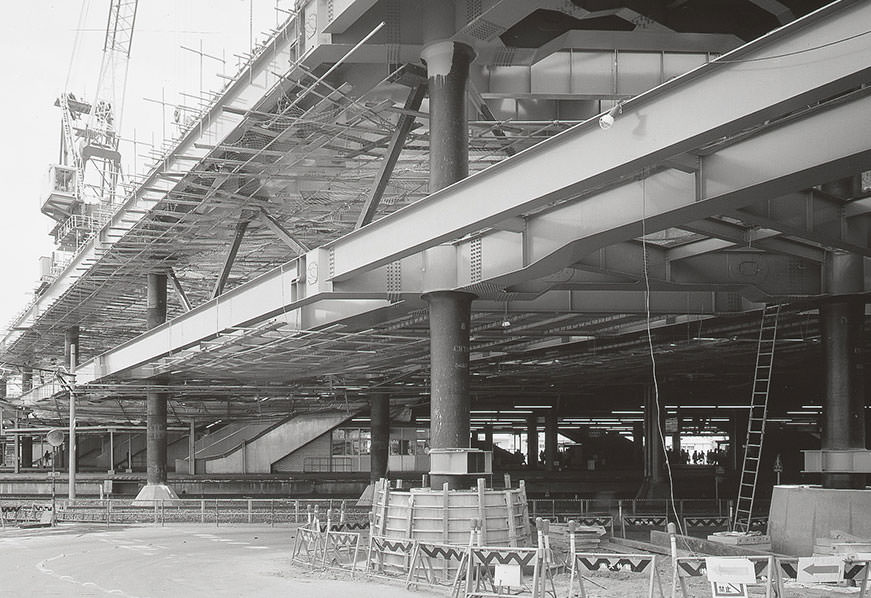 G Column supporting the Shin-Osaka bullet train station
G Column supporting the Shin-Osaka bullet train station
Created the World’s First Dual-Layered Roll Using Centrifugal Casting. Kubota Became a Leading Manufacturer in the Industry, Capturing Other Countries’ Attention
In 1954, Kubota developed ductile cast iron rolls with both excellent strength and durability, officially entering the iron and steel mill roll industry. As different qualities are sought in steel mill rolls, Kubota continued its research and developed the world’s first commercialized centrifugal cast dual-layer mill roll. Child high-alloy cast iron is used for the outer layer and high-grade cast iron for the inner layer. This mill roll, which combined two different materials into one roll through centrifugal casting without separating them, achieved five times longer product life. At the World Foundry Congress in 1968, Kubota attracted the attention of each country and this triggered export expansion. In the same year, its production reached 1,000 tons a month, and Kubota established its status as a major manufacturer of the industry.
 Ring sample of a two-layered centrifugal casting pipe,
Ring sample of a two-layered centrifugal casting pipe,
which enabled the use of different materials for the outer and inner layer
Development of Spiral Steel Pipe Prototypes and Started Manufacturing Them at Dedicated Plant. Expanded Its Market as Foundation Piles
In 1957, Kubota purchased spiral steel pipe manufacturing techniques from the U.S. Armco, Inc. This technique made it easier to manufacture longer rolls as it enabled continuous pipe production by forming and welding hot rolling coils in a spiral. Originally, it was used to produce water pipes, but as 20% of Armco’s production was for foundation piles, Kubota also expanded sales route. At that time, the reclamation of coastal areas was popular, and, for port facilities over soft ground and foundation piles for factories, the use of H-shaped steel and steel pipes increased for their durability over conventional concrete piles. Kubota enhanced its productivity and was able to win over the fierce competition among steel manufacturers.
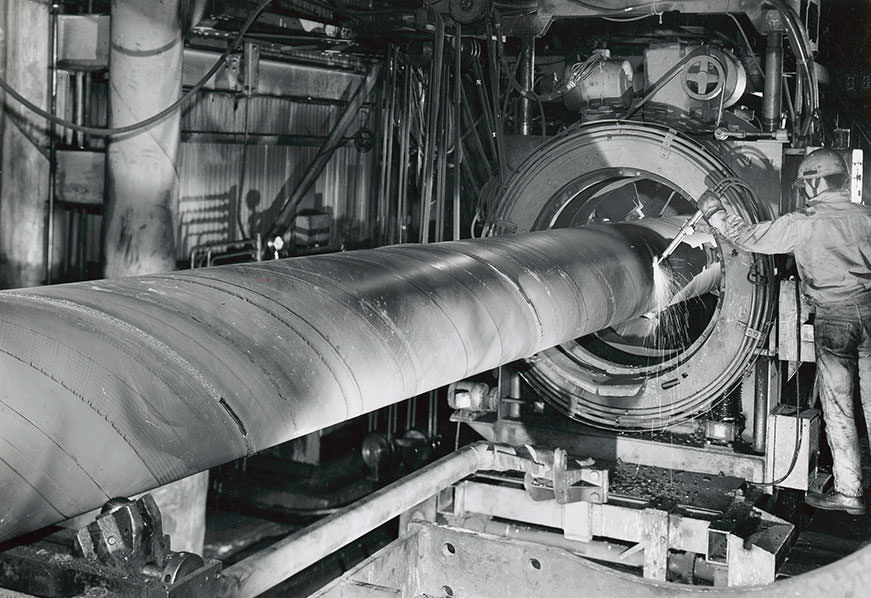 Manufacturing spiral steel pipes by forming and welding
Manufacturing spiral steel pipes by forming and welding
the hot rolling coil in spiral
1970s
Kubota’s Symbolic Cast Steel Product
that Supported the Shipbuilding Boom
As the “Building a New Japan” boom started and the development of transportation network accelerated, public works projects also increased. Thus, the civil engineering industry began to thrive even more. Accordingly, the steel pipe pile industry also flourished. Construction works became larger in scale, and the demand for products also changed.
Scroll to See Next Story
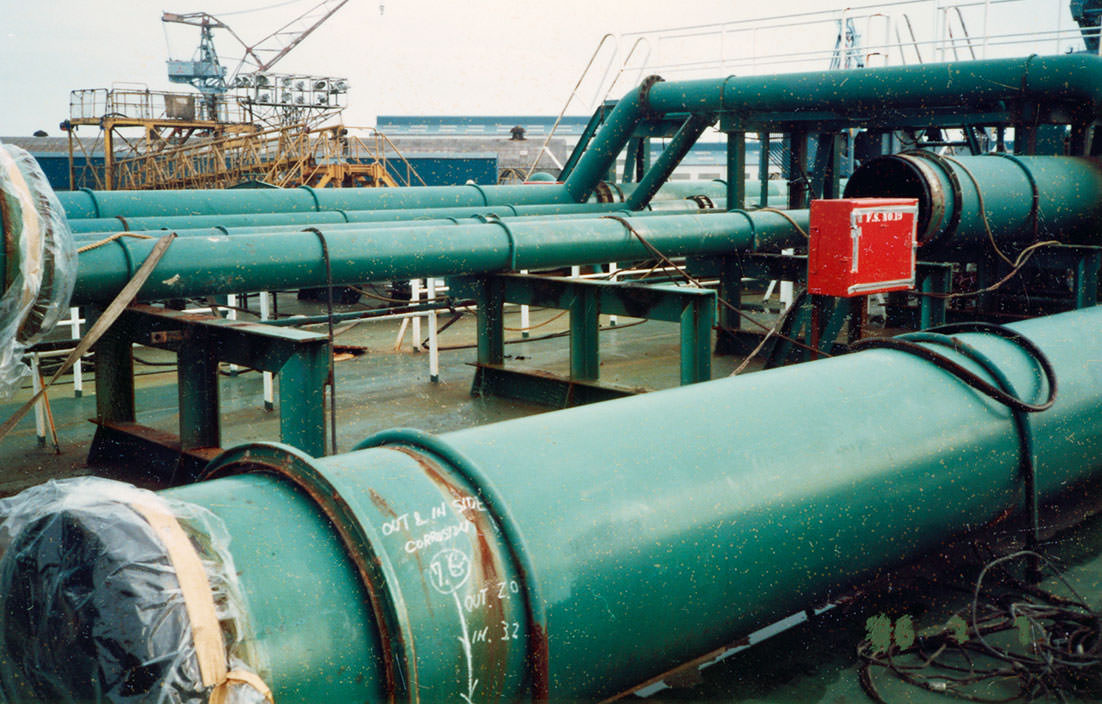
1970s
Creation of Kubota’s Symbolic Cast Steel Product
Through the Expansion of Its Steel Pipe Business
Spiral Steel Pipe Pile, Cargo Oil Pipe
Cast steel cargo oil pipes laid out on a tanker’s deck to transport oil
The “Building a New Japan” boom encouraged a sudden rise in the demand for oil as well, and the construction of large-scale tankers continued. With the resulting shipbuilding boom, Kubota, which had been pursuing product originality in the cast steel business with the production of special steel pipes, created one more new cast steel product representative of it.
With the Increase in Oil Demand, Cargo Oil Pipes for Tankers Became One of Kubota’s Representative Cast Steel Products
Around 1970, in proportion to the increase in oil demand, the demand rose for the construction of extra-large tankers that were 200,000 tons and over. With this, cargo oil pipes, which are used for piping oil tankers, suddenly grew and joined the cast steel products that represented Kubota. It was first installed in the Texaco (United States)’s* oil tankers at the end of the 1950s, receiving good reviews for its superior corrosion resistance and weldability. In 1973, Kubota set up a structure to produce 1,500 tons per month and launched a cast steel business division to enable coordination with the production of G Columns. In the following year, it developed 25,000 tons and continued to grow until the oil crisis.
*Texaco is current Chevron Corporation.
A Civil Engineering and Construction Rush with the “Building a New Japan” Boom. The Industry for Cast Steel Pipe Piles Also Thrive
In 1972, Kubota absorbed Kanto Daikei Koukan K. K., which manufactured spiral pipes, and renamed their facility Ichikawa Plant. Soon, the “Building a New Japan” boom took place and the steel pipe pile industry began to flourish again. Civil engineering demand increased and, due to the larger construction projects, thicker, wider-diameter, and longer piles were sought for at construction sites. The demand for high-quality water sealing steel sheet pipes, which were frequently used in revetments and cofferdams, has also increased. Although the production of Kubota’s steel pipes reached 250,000 tons in 1973, it built a facility for processing long piles and steel sheets near the Ichikawa Plant, still working to expand its capacity and respond to the changes in needs and increase in work orders.
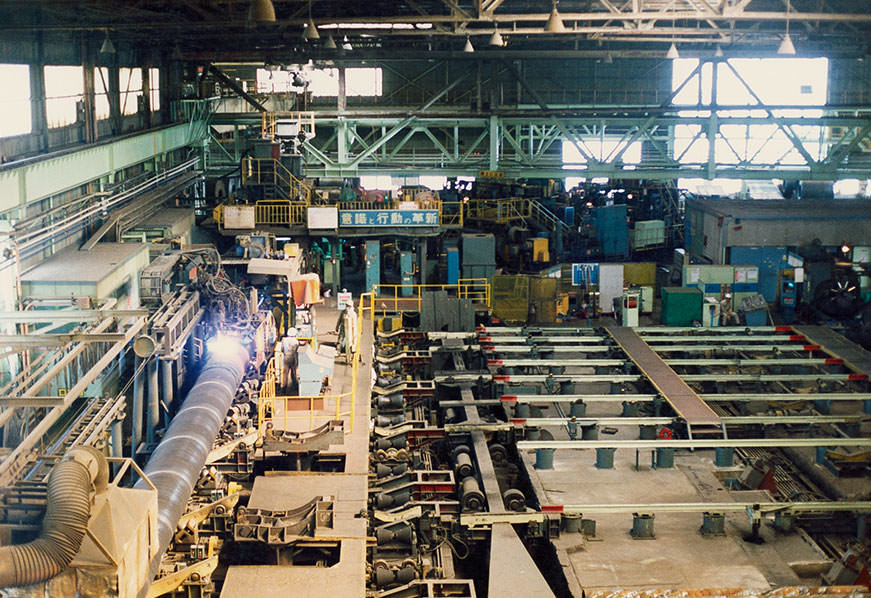 The second pipe manufacturing machine installed in the Ichikawa Plant
The second pipe manufacturing machine installed in the Ichikawa Plant
1970-1980s
The Oil Crises Brought on Changes
to the Industrial Structure and Innovation
In 1973, oil prices exponentially rose as a result of the oil crisis, and the world was at once plunged into recession. As one way to overcome this crisis, countries promoted energy and resource efficiency. However, this brought on a change to the industrial structure and encouraged the development of new technologies and products.
Scroll to See Next Story
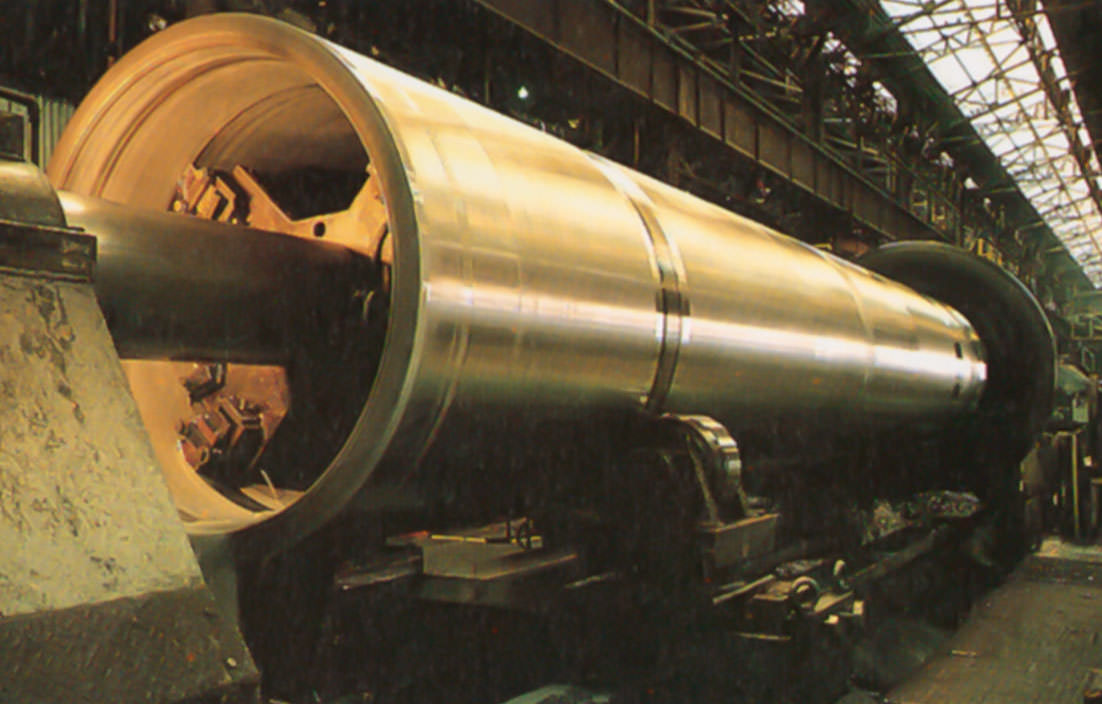
1970-1980s
Restructuring the Business
After the Oil Crisis
Cylinder Liner, Hearth Roll, Suction Roll, Reformer & Cracking Tube,
Cast Iron Parts for Nuclear Power Generation
Suction roll shell for paper manufacturing machines produced at the Hirakata steel casting foundry
The greatest recession since the war, which was caused by the oil crisis, greatly impacted Kubota’s business, as well. Energy and resource efficiencies were reviewed, and Kubota thoroughly reformed itself by reorganizing itself and enhancing its competitiveness in the market. This became an opportunity to develop new technologies and products.
Overcoming the Oil Crisis—Kubota Found a Way Forward in the Auto and Civil Engineering Market
The casting and steel business, which was hit hard by the oil crisis, started to look for a new direction in order to survive. The Castings Division focused on the mass production of castings for the automobile, public works, and construction market. The Steel Casting Division developed technology for high-value-added products and entered the field of product installation work. Since 1978, Kubota continued to receive orders for cast iron engines from Toyo Kogyo (current Mazda) and Yamaha Motor Company. Furthermore, it started manufacturing long cylinder sleeve materials for engines in each factory, taking advantage of centrifugal casting. In addition, the demand for hearth rolls to be installed in automotive steel sheet plants also rose, and Kubota expanded its production of heat resistant cast steel products.
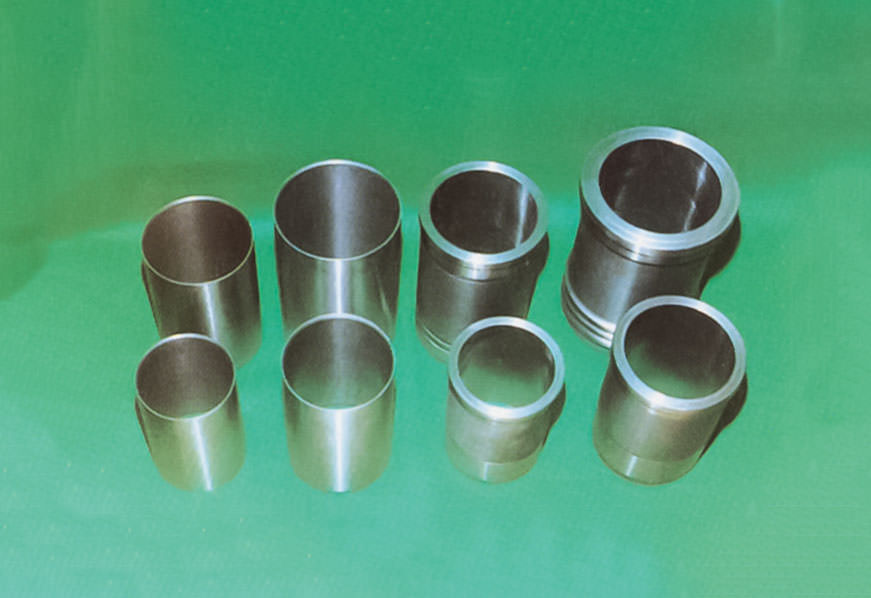 Cylinder liners for different types of engines,
Cylinder liners for different types of engines,
manufactured through centrifugal casting
New Technologies Lead to Creating Products One after Another. Along with the Trend of Internationalization of Businesses, the Proportion of Cast Steel Products Exported Suddenly Grew
Around this time, the Steel Casting Division developed various new technologies and products. Robots that scanned the reformer tube already installed in petrochemical plants with ultrasonic waves were applied to tanker oil pipes, establishing a new independent business area for evaluation of remaining tube life. Furthermore, suction roll shells, which Kubota supplied to Voith GmbH (former West Germany), brought about expansion in exports and became a stable exporting good to Europe. Since 1975, with the aim of internationalizing, Kubota succeeded in receiving large-scale orders from the United States and Russia for reformer tube and stainless cast steel products for nuclear power generation. With an integrated sales, production, and research system on a global scale, Kubota’s export ratio rapidly grew.
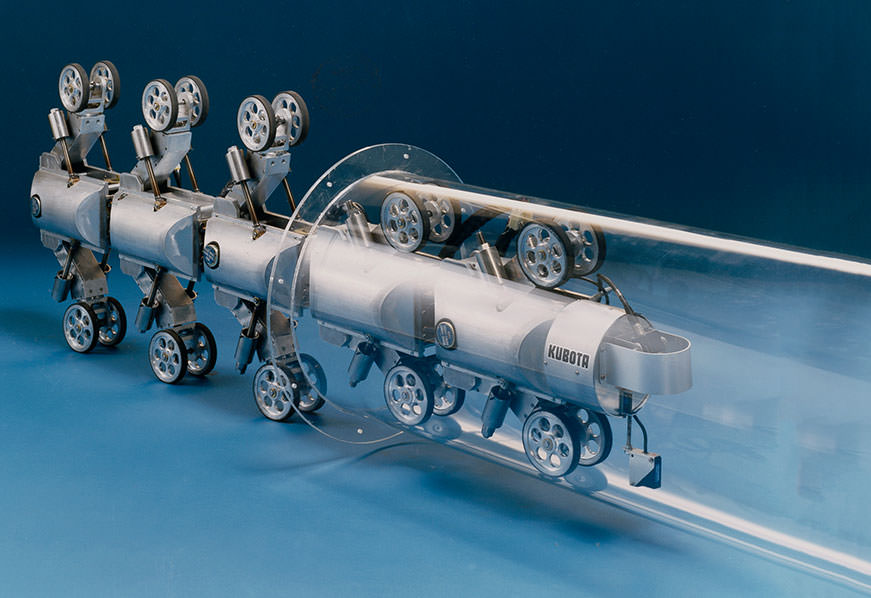 A robot that diagnoses the remaining amount of endurance of a cargo oil pipe
A robot that diagnoses the remaining amount of endurance of a cargo oil pipe
using ultrasonic waves
Under Proactive Global Strategy, Kubota Promoted Its Steel Rolls Overseas and Was Selected among the World’s Steel Producers
Kubota’s rolling-mill rolls were exported to such countries as India, South Africa, Malaysia, and the Philippines starting around 1960 and expanded all around the world. The technology for centrifugal cast composite rolls, in particular, was received highly worldwide, and, in 1970, Kubota licensed its technology to the Akers Company (Sweden), Furthermore, it proactively promoted the global marketing strategy and delivered 3-layered High-Chrome rolls for Hot Strip Mill to major steel producers in the United States, Europe, Australia, etc. In addition, it developed the composite Adamite roll for shape rolling and received high acclaim. Its export also increased from 580 tons in 1975 to 3,950 tons in 1982.
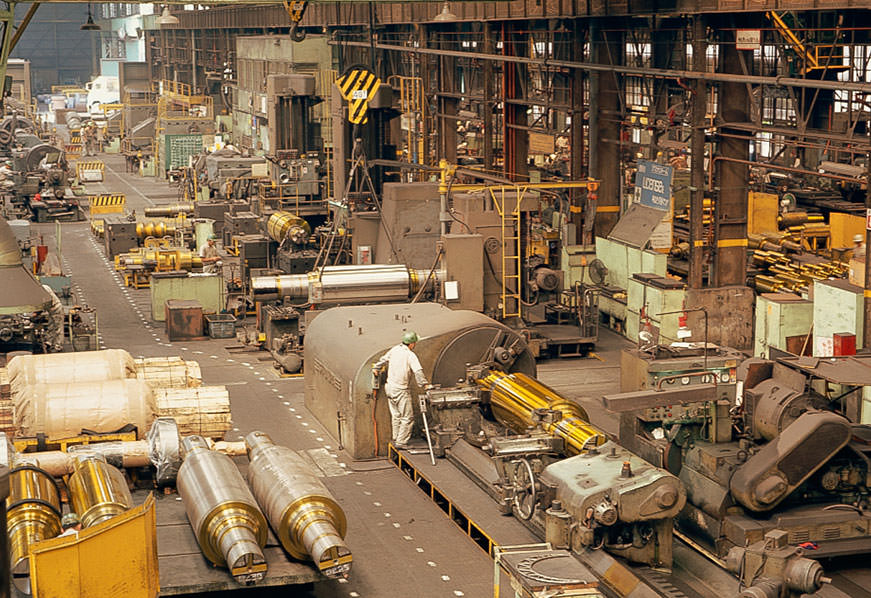 Processing rolling-mill rolls at the Amagasaki plant.
Processing rolling-mill rolls at the Amagasaki plant.
1980-2000s
The Bubble Economy and the Diversification of Customer Needs
Due to the rise and fall of the bubble economy triggered by the depreciation in Japanese yen, the country entered a period of long economic stagnation. While domestic demand faltered, the diversification of customer needs further accelerated. In order to respond to this diversification and differentiate its products, industries focused on developing new products and materials.
Scroll to See Next Story
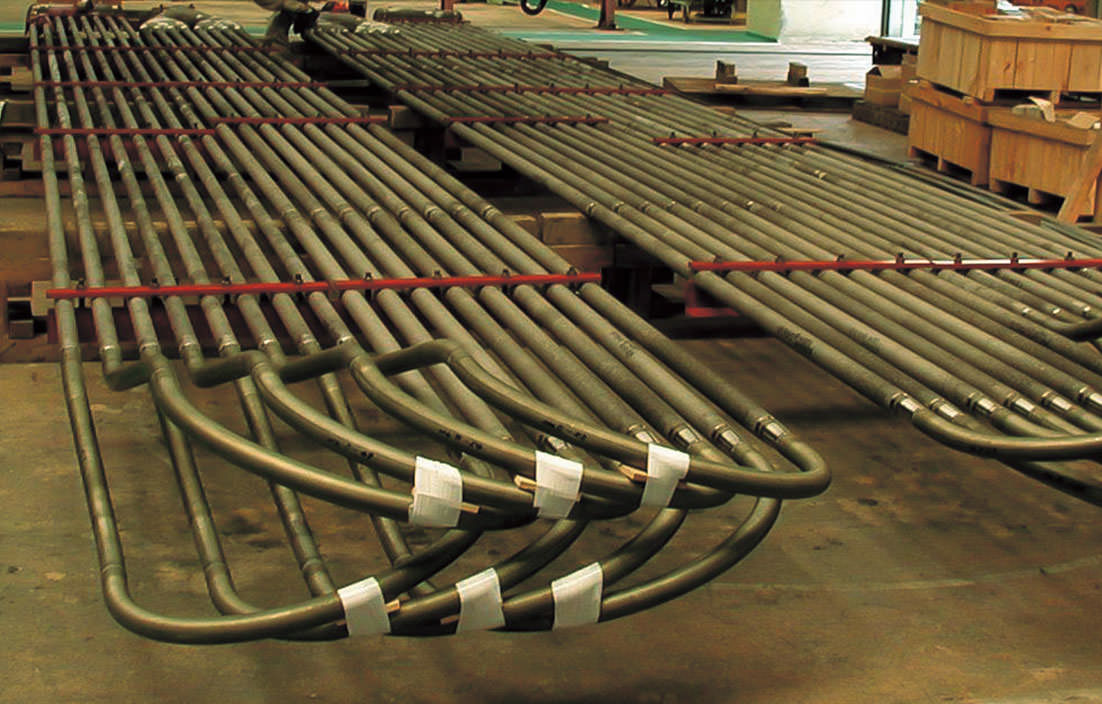
1980-2000s
The Birth of the Materials Business.
Kubota Expanded its Domain
with New Materials and New Technologies
Reformer & Cracking Tube, Skid Button, Composite Ring Roll
Cracking coils used for the production of ethylene for petrochemicals
With the diversification of customer needs, Kubota integrated the 3 business divisions--casting, iron and steel, and cast mold roll, newly creating the Material Consolidated Division. While strengthening the casting-related divisions, it expanded into a new business area under the concept of “materials,” responding to diversifying needs with new materials and technologies.
Starting with Canada and China, Kubota Started to Actively Expand Its Business in the Overseas Petrochemical Market
Cracking coils, which are installed in steam cracker units that produce ethylene for the petrochemical industry, are one of Kubota Materials Business’s key products. In order to respond to diverse customer needs, Kubota developed a new type of cracking tube called the Mixing Element Radiant Tube (MERT). It is an original product, which has mixing function with a spiral element on the internal surface of the tube. By improving thermal conductivity and evenly heating the fluid inside the tube, it dramatically improved the efficiency of steam cracker units. Kubota’s in-depth knowledge of and abundant experience in centrifugal casting realized this difficult product.
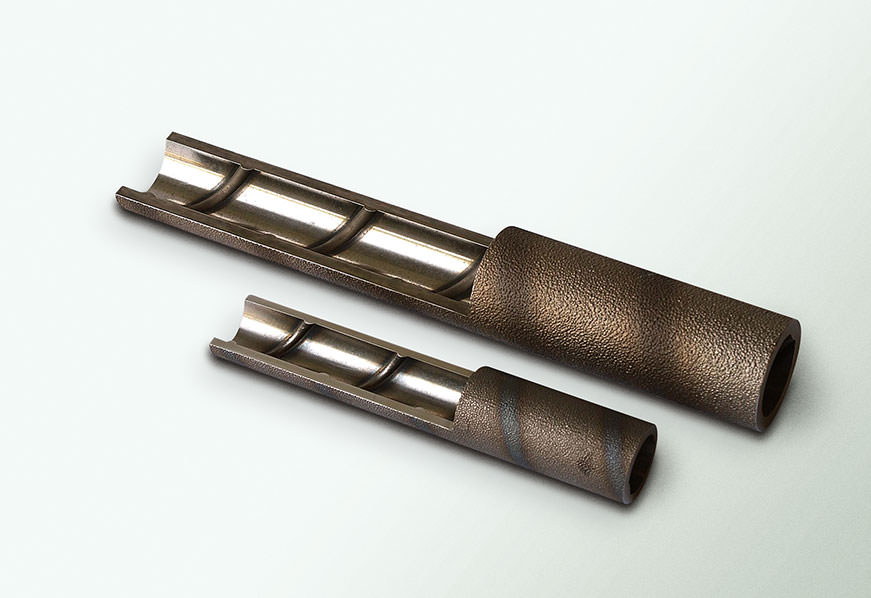 With a mixing element inside the tube, MERT has improved thermal conductivity
With a mixing element inside the tube, MERT has improved thermal conductivity
and enabled even temperature distribution of the fluid inside
Applying a New Compound to the World’s First 2-Layer Cracking Tube. A Product Kubota Developed in Collaboration with another Company Received Worldwide Recognition
In order to open a new market, Kubota started developing composite materials with other companies. In 1984, Kubota collaborated with Toyo Engineering Corporation and developed the CORET tube, a cracking tube in ethylene production facilities. It applied a material with low carbon deposition rate to its interior. The world’s first 2-layer cracking tube received high acclaim both domestically and abroad, being adopted by chemical companies around the world, including ICI (Imperial Chemical Industries, United Kingdom). Furthermore, in collaboration with Kawasaki Steel Corporation and Chugai Ro Co., Ltd., Kubota developed a metal composite with cast steel and ceramics. The 1,250℃ heat resistant, steel sheet furnace flooring supply (skid button) made with this material won the 3rd Sokeizai Industry Technology Award, receiving positive reviews from steel producers.
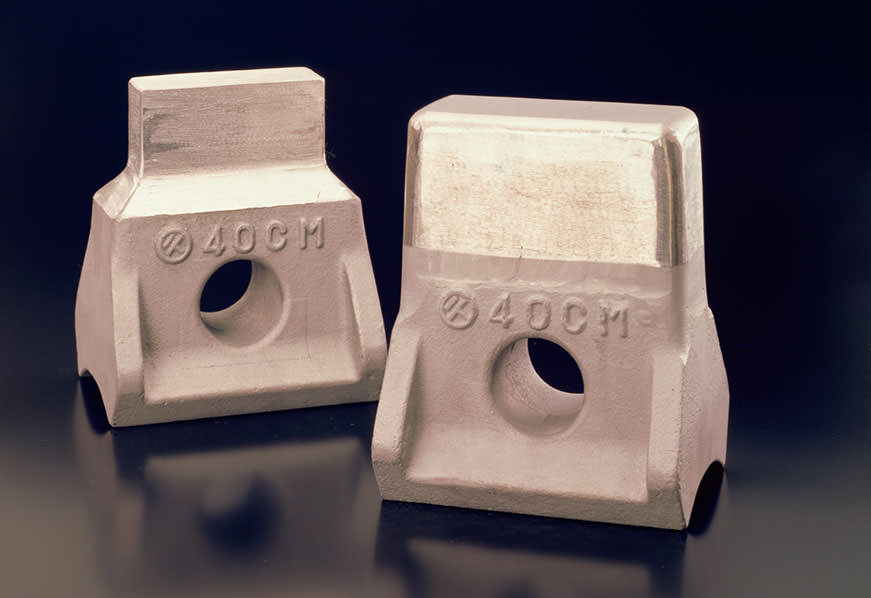 A steel sheet furnace flooring supply (skid button) made with
A steel sheet furnace flooring supply (skid button) made with
a cast steel and ceramics composite
Improved Durability by 10 Times. Kubota’s “Composite Ring Roll” Was Selected as a Noteworthy Invention by the Science and Technology Agency
The problems rolling-mill rolls had at the time were “the short rolling pitch, which was compromised to improve productivity, and the increasing heat-load to the exterior surface of the roll.” In 1988, Kubota invented the HIP Shaping Composite Ring Roll for steel bar and section mill, which was 10 times more durable than conventional rolls. Highly heat-resistant and shockproof low-carbon steel was used for the welding base metal, and highly wear-resistant steel powder was processed through hot isostatic pressing (HIP) for the outer layer, realizing high-precision shaping and consistent quality. It received a favorable reputation with such features as its solid boundary and non-detachable mechanism and was selected as a noteworthy invention by the Science and Technology Agency.
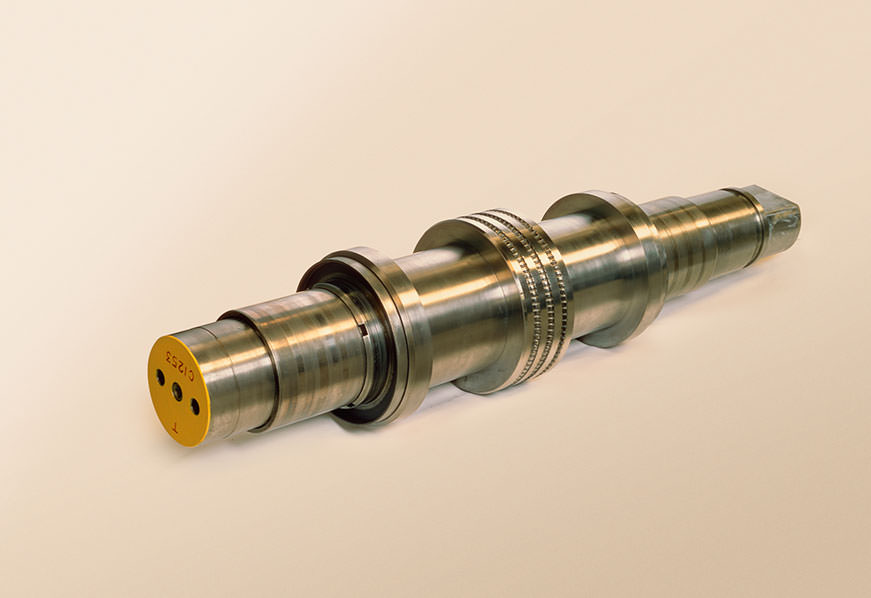 HIP Shaping Composite Ring Roll,
HIP Shaping Composite Ring Roll,
which is 10 times more durable than conventional rolls
2000s-
The Acceleration of Economic Globalization
and Diversification of Needs
In recent years, economic globalization has progressed at an unprecedented pace, and emerging countries such as China, Russia, India, and Brazil have developed economically. Meanwhile, with a weak economy, Japanese businesses have stagnated altogether, and industries rapidly pursued rationalization, as customer needs further diversified.
Scroll to See Next Story
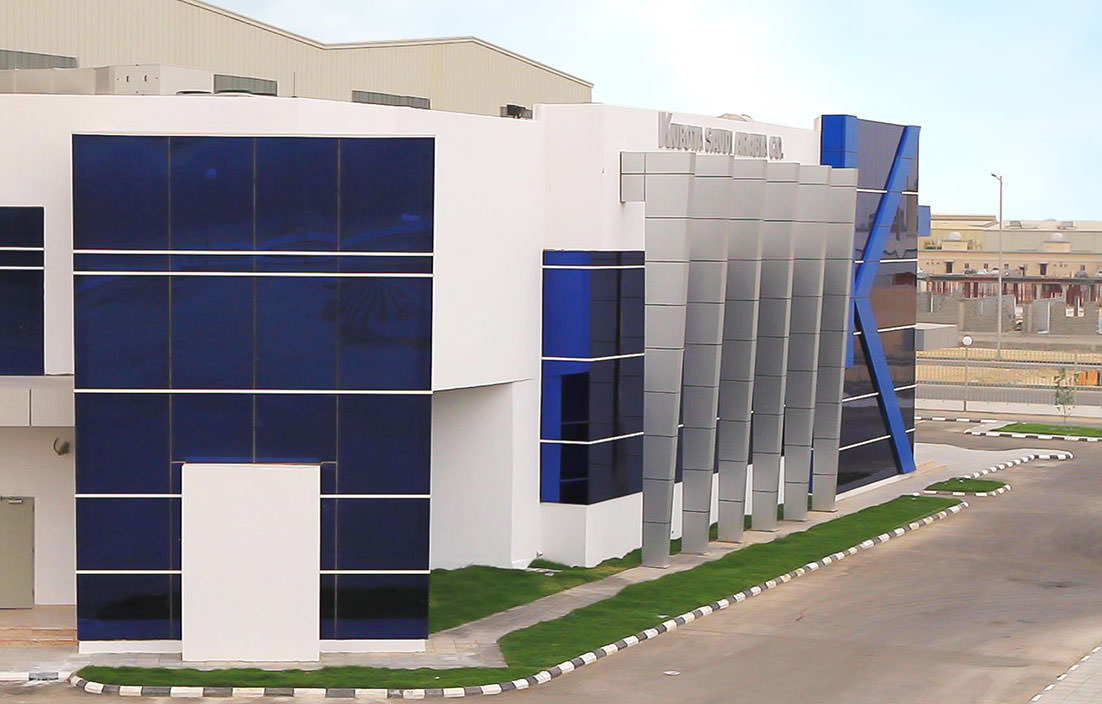
2000s-
The Globalization of Kubota’s Business
and the Increasing Segmentation of Customer Needs
Reformer & Cracking Tube, TXAX, Laqnican Joint
A cast steel production factory established in Saudi Arabia to produce reformer & cracking tube made of heat-resistant cast steel
In response to rapid economic globalization, Kubota strengthened its business foundation for public sector demand and promoted an overseas growth strategy since 2003. Emerging countries, in particular, are economically developing and increasing their demand for forged materials. Kubota is responding to this demand with its technology and expertise.
Advancing to the Middle East and Beginning the Production of TXAX in Canada. With the Expansion of Overseas Production Bases, Kubota Encloses the Global Market
In 2009, Kubota established a cast steel product manufacturing and sales company Kubota Saudi Arabia Company, LLC in Saudi Arabia. While there were many global ethylene companies locally present, Kubota worked on producing and selling cracking tubes for petrochemical plants in the Middle East, North Africa, and Europe. This was a stepping-stone for further global development. In 2013, it established a new plant at Kubota Materials, Canada and resumed the mass production of potassium titanate TXAX, used as friction material for automotive brake pads. In North America, Kubota decided to mass-produce TXAX, which had superior heat and wear-resistance qualities, as the demand for friction material potassium titanate was expected to expand with the switch to environmentally conscious, asbestos-free pads and the increase in new car installation.
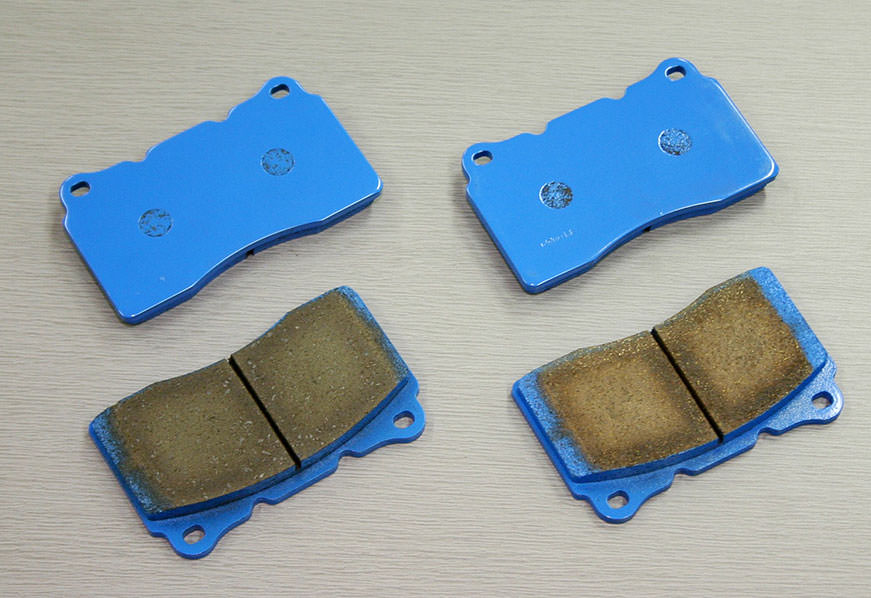 Brake pads made of TXAX excel in heat-resistance, insulation,
Brake pads made of TXAX excel in heat-resistance, insulation,
and wear-resistance
Reducing Construction Time, Lowering Cost, and Environmentally Conscious. Kubota Realizes a Product Lineup that Meets Various Needs for Rationalization
It is not easy to undertake construction work with urban development restrictions, environmental standards, and limited facilities budget. Thus, various needs for rationalization started to rise, such as longer product life of pipelines, reduction of construction time, and resource conservation. Kubota presented technologies and products that responded to these needs, one after another. These include the Laqnican Joint, which directly reduced construction time, the SGE construction method, which largely reduced construction cost, the next generation cracking tube AFTALLOY with a long-operation time, thermal and collision-resistant coiler drum, ANK400 which extends the operation of ethylene plants. Kubota is also greatly contributing to updating old infrastructure developed during the rapid economic growth.
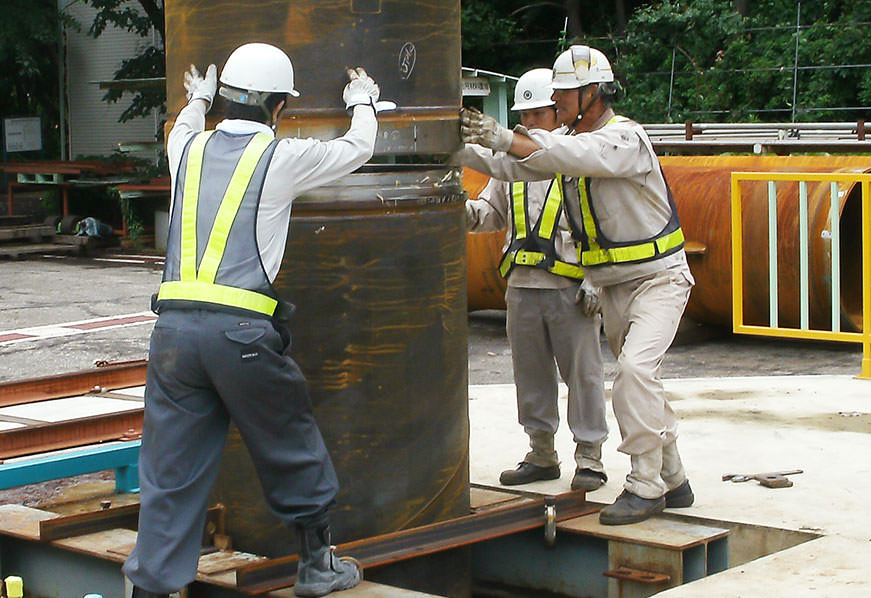 Laqnican Joint—a mechanical joint which assures stable quality jointing
Laqnican Joint—a mechanical joint which assures stable quality jointing
Kubota’s Casting Roots Gave Rise to Materials Business that Support the World’s Industry
Kubota’s original business of casting gave rise to the materials business. It can be said that the history of materials, which gave rise to many technologies and products polished by the times and market needs, is the history of Kubota itself. Kubota’s materials will continue to respond to customers’ needs, polish its skills, and support the world’s industry by developing new products.
